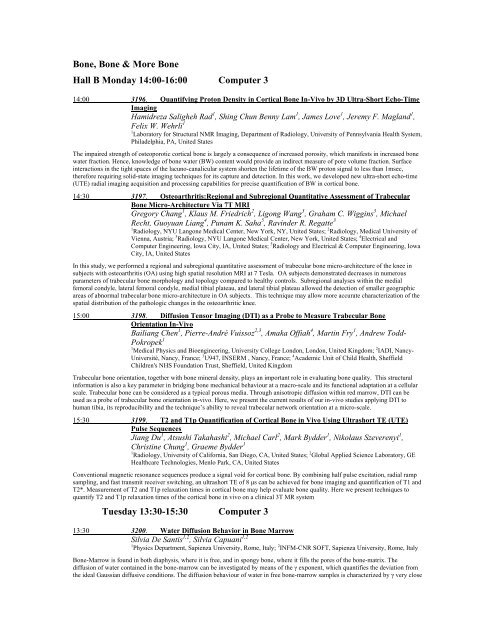ELECTRONIC POSTER - ismrm
ELECTRONIC POSTER - ismrm
ELECTRONIC POSTER - ismrm
Create successful ePaper yourself
Turn your PDF publications into a flip-book with our unique Google optimized e-Paper software.
Bone, Bone & More Bone<br />
Hall B Monday 14:00-16:00 Computer 3<br />
14:00 3196. Quantifying Proton Density in Cortical Bone In-Vivo by 3D Ultra-Short Echo-Time<br />
Imaging<br />
Hamidreza Saligheh Rad 1 , Shing Chun Benny Lam 1 , James Love 1 , Jeremy F. Magland 1 ,<br />
Felix W. Wehrli 1<br />
1 Laboratory for Structural NMR Imaging, Department of Radiology, University of Pennsylvania Health System,<br />
Philadelphia, PA, United States<br />
The impaired strength of osteoporotic cortical bone is largely a consequence of increased porosity, which manifests in increased bone<br />
water fraction. Hence, knowledge of bone water (BW) content would provide an indirect measure of pore volume fraction. Surface<br />
interactions in the tight spaces of the lacuno-canalicular system shorten the lifetime of the BW proton signal to less than 1msec,<br />
therefore requiring solid-state imaging techniques for its capture and detection. In this work, we developed new ultra-short echo-time<br />
(UTE) radial imaging acquisition and processing capabilities for precise quantification of BW in cortical bone.<br />
14:30 3197. Osteoarthritis:Regional and Subregional Quantitative Assessment of Trabecular<br />
Bone Micro-Architecture Via 7T MRI<br />
Gregory Chang 1 , Klaus M. Friedrich 2 , Ligong Wang 3 , Graham C. Wiggins 3 , Michael<br />
Recht, Guoyuan Liang 4 , Punam K. Saha 5 , Ravinder R. Regatte 3<br />
1 Radiology, NYU Langone Medical Center, New York, NY, United States; 2 Radiology, Medical University of<br />
Vienna, Austria; 3 Radiology, NYU Langone Medical Center, New York, United States; 4 Electrical and<br />
Computer Engineering, Iowa City, IA, United States; 5 Radiology and Electrical & Computer Engineering, Iowa<br />
City, IA, United States<br />
In this study, we performed a regional and subregional quantitative assessment of trabecular bone micro-architecture of the knee in<br />
subjects with osteoarthritis (OA) using high spatial resolution MRI at 7 Tesla. OA subjects demonstrated decreases in numerous<br />
parameters of trabecular bone morphology and topology compared to healthy controls. Subregional analyses within the medial<br />
femoral condyle, lateral femoral condyle, medial tibial plateau, and lateral tibial plateau allowed the detection of smaller geographic<br />
areas of abnormal trabecular bone micro-architecture in OA subjects. This technique may allow more accurate characterization of the<br />
spatial distribution of the pathologic changes in the osteoarthritic knee.<br />
15:00 3198. Diffusion Tensor Imaging (DTI) as a Probe to Measure Trabecular Bone<br />
Orientation In-Vivo<br />
Bailiang Chen 1 , Pierre-André Vuissoz 2,3 , Amaka Offiah 4 , Martin Fry 1 , Andrew Todd-<br />
Pokropek 1<br />
1 Medical Physics and Bioengineering, University College London, London, United Kingdom; 2 IADI, Nancy-<br />
Université, Nancy, France; 3 U947, INSERM , Nancy, France; 4 Academic Unit of Child Health, Sheffield<br />
Children's NHS Foundation Trust, Sheffield, United Kingdom<br />
Trabecular bone orientation, together with bone mineral density, plays an important role in evaluating bone quality. This structural<br />
information is also a key parameter in bridging bone mechanical behaviour at a macro-scale and its functional adaptation at a cellular<br />
scale. Trabecular bone can be considered as a typical porous media. Through anisotropic diffusion within red marrow, DTI can be<br />
used as a probe of trabecular bone orientation in-vivo. Here, we present the current results of our in-vivo studies applying DTI to<br />
human tibia, its reproducibility and the technique’s ability to reveal trabecular network orientation at a micro-scale.<br />
15:30 3199. T2 and T1p Quantification of Cortical Bone in Vivo Using Ultrashort TE (UTE)<br />
Pulse Sequences<br />
Jiang Du 1 , Atsushi Takahashi 2 , Michael Carl 2 , Mark Bydder 1 , Nikolaus Szeverenyi 1 ,<br />
Christine Chung 1 , Graeme Bydder 1<br />
1 Radiology, University of California, San Diego, CA, United States; 2 Global Applied Science Laboratory, GE<br />
Healthcare Technologies, Menlo Park, CA, United States<br />
Conventional magnetic resonance sequences produce a signal void for cortical bone. By combining half pulse excitation, radial ramp<br />
sampling, and fast transmit receiver switching, an ultrashort TE of 8 μs can be achieved for bone imaging and quantification of T1 and<br />
T2*. Measurement of T2 and T1p relaxation times in cortical bone may help evaluate bone quality. Here we present techniques to<br />
quantify T2 and T1p relaxation times of the cortical bone in vivo on a clinical 3T MR system<br />
Tuesday 13:30-15:30 Computer 3<br />
13:30 3200. Water Diffusion Behavior in Bone Marrow<br />
Silvia De Santis 1,2 , Silvia Capuani 1,2<br />
1 Physics Department, Sapienza University, Rome, Italy; 2 INFM-CNR SOFT, Sapienza University, Rome, Italy<br />
Bone-Marrow is found in both diaphysis, where it is free, and in spongy bone, where it fills the pores of the bone-matrix. The<br />
diffusion of water contained in the bone-marrow can be investigated by means of the γ exponent, which quantifies the deviation from<br />
the ideal Gaussian diffusive conditions. The diffusion behaviour of water in free bone-marrow samples is characterized by γ very close
















